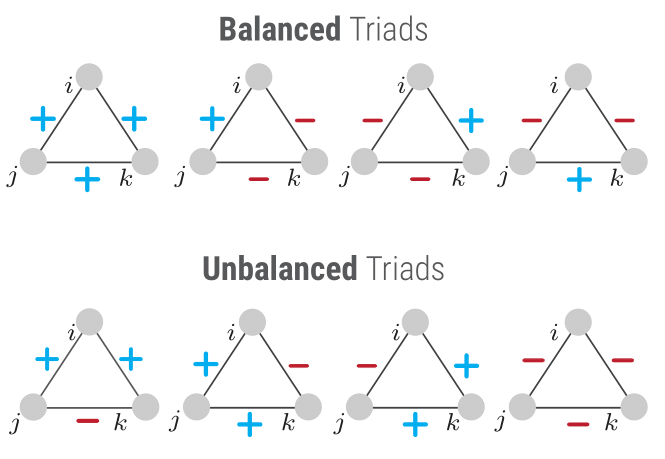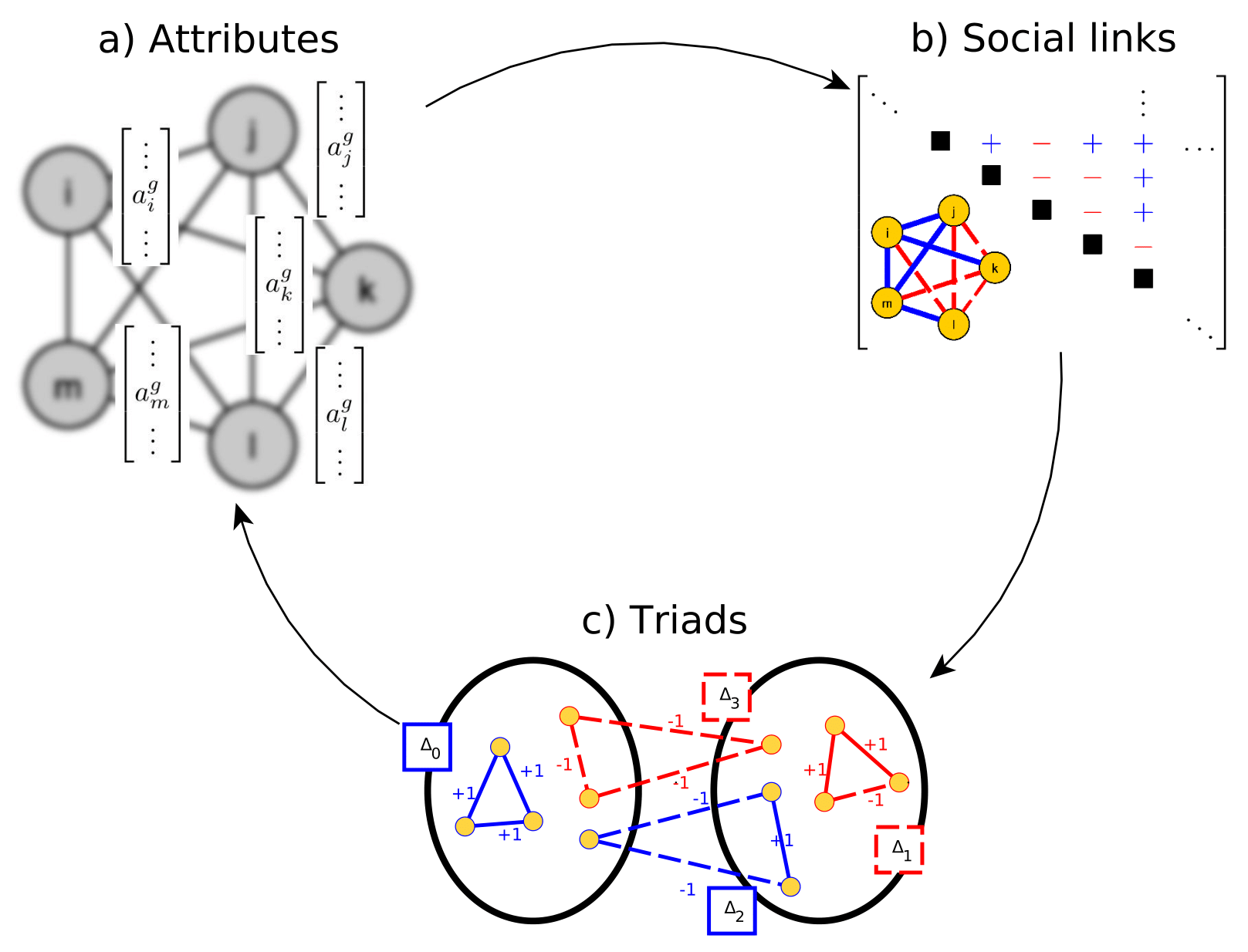Project title: Signed Relations and Structural Balance in Complex Systems: From Data to Models
Project duration: 2020 – 2023
Budget: 1 503 386 PLN
Project coordinator: Janusz Hołyst, http://www.if.pw.edu.pl/~jholyst/
Partners
The Project is a cooperation of Warsaw University of Technology (Principal Investigator Prof. Janusz Holyst) and ETH Zurich (Principal Investigator Prof. Frank Schweitzer), funded through a bi-lateral Polish National Science Center and Swiss National Science Foundation programme ALPHORN. See more about our partner: https://www.sg.ethz.ch/
Description for the general public

Nowadays the development of technology and the holistic view on science decreased the boundary between hard (e.g., mathematics, physics) and soft (e.g., sociology, psychology) sciences. New big datasets and the application of physics methods enabled broader approach to the analysis of the processes in the society, which led to fast development of interdisciplinary studies, e.g. sociophysics. Our project belongs to such research, since it combines the knowledge and methodology from physics and data exploration in order to verify hypothesis from psychology – Heider’s theory of structural balance. To this end we apply among others statistical physics models of multi-body interactions and methods for their dynamics analysis.
Let us imagine the following case. We have two friends who don’t like each other. Can we stay on good terms with both of them? Is it easy to organize a common meeting? According to the theory of structural balance such a system is unbalanced and existing conflicts will drive system’s evolution towards decreasing tensions. Going back to above example one of the friends could break the relation with us or thanks to our efforts they may become friends. Theory of structural balance claims that a system of agents (i.e., people, organizations) is balanced, when following four rules are fulfilled: “friend of my friend is my friend”, “friend of my enemy is my enemy”, “enemy of my friend is my enemy” and “enemy of my enemy is my friend”. Above rules were translated to the language of complex networks. Signed networks were used. These are the structures of agents (nodes) and links (edges) connecting them, where all the links are assigned a positive or negative sign. Such a signed relation corresponds to positive or negative relations among agents.
Past research in sociophysics and social sciences verified the hypothesis of structural balance theory only in very limited fashion. Such studies needs proper data, that is difficult to obtain and in consequence rare. Usually real data on social networks include, for instance, only information about conversations or face-to-face interactions. The information about signed relations is missing. In this project we will create methods on how to extract link signs from data about how people interact between themselves. Obtaining real data of signed networks will let us study the evolution of structural balance. Past research suggests such systems are close to being balanced, but never are. That’s why the next goal of this project is building agent based models of social systems, that will let us understand how the relations between people evolve and influence their behavior. Is structural balance really playing an important role in social relations? Or is similarity of opinions more important? Do we speak with friends more frequently than we quarrel with enemies? If we know who talks with whom, can we determine who is a friend and who is a foe, without knowing topics of the discussions? To answer above questions we will apply network models of agents possessing attributes describing their characteristic features (e.g., age, ethnicity, opinions), similar to models of magnetic materials or other multi-body models in statistical physics. In the last step we will verify whether created models describe real human behavior observed in different data sets well. Since humans behave differently in various situations, we will first need to calibrate our models in order to describe behavior in different situations. Model analysis will let us better understand what influences social interactions and evolution of human relations. In particular, we will learn which of many possible mechanisms are significant and which are not, especially whether structural balance theory has significant impact on decisions who is our friend and who is not.
Summing up, in this project we will apply methods of statistical physics and data exploration to create new methods and models giving rise to better understanding how interactions among humans translate to their relations and vice versa, and how these relations change in time.
Summary of the research plan
According to the theory of structural balance (Fig. 1), interacting systems balance the (positive or negative) relations between different system elements such that local conflicts are minimized. Hence, structural imbalances induce a dynamics to resolve such conflicts. This dynamics plays a vital role in evolutionary processes because a multitude of possible solutions exists. At the same time, if these solutions cannot be reached, this can hamper the functionality of systems. This general problem also occurs in social systems, where instead of a more balanced state, for instance, the polarization of opinions emerges. Are we able to address this problem from a formal perspective? Do we have data available to study it in real systems? Can we develop models that help us to understand when structural balance fails, and how it can be mitigated?
Data about interactions between system elements (agents) is ubiquitous. This applies particularly to interactions between individuals, thanks to new communication technologies, sensor recordings, and online interactions. To analyze, to model and to interpret these data, however, is one of the biggest challenges for data science. Instead of applying existing methodologies to just another data set, we need to implement system specific concepts. Such problems do not just concern data analysis, they pertain even more to the modeling of such systems. This proposal makes an important step forward, by addressing these methodological challenges. To understand structural balance, the differences between many-particle systems and socio-economic multi-agent systems need to be addressed. While in physical systems with given spin-spin interactions, spins try to align such that the local frustration is minimized, in social systems agents have the opportunity to also change the sign of their relations, to obtain a better balanced state. But how do we know about their signed relations, for example their friend-or-foe relationship? The data in almost all cases records only the observed interactions, but to model and to understand the problem of structural balance, we need their relations. Therefore, in this project, we first solve the methodological problem of inferring signed relations from interactions by developing a novel statistical approach to analyze such data.

Structural balance theory provides hypotheses of how unbalanced relations are settled that have been hardly tested for real-world systems. To investigate how structural balance evolves over time, we have to solve the problem that agents’ attributes, relations and interactions change on different time scales and therefore need to be identified and separated. We will further develop a new agent-based model (ABM) that considers the co-evolution of attributes and signed relations of agents (Fig. 2), to understand how these constrain their interactions. Through a novel calibration-validation procedure developed in this project, the formal ABM will then be turned into a data-driven model. It takes data from real-world systems as input to reproduce their dynamics of structural balance. This way, we produce new data sets about the evolution of signed relations in social systems and at the same time, also provide a calibrated and validated interaction model to understand how structural balance evolves.
These insights will help to understand the problem of structural balance in a comprehensive and novel manner. This concerns the theoretical perspective, where we provide methodologies to link structural balance to the inference problem of signed relations and, subsequently, to observed interactions. It also regards the applied perspective, where we provide an interaction model calibrated and validated against real-world data. This opens new avenues towards research questions that were difficult to address before, like the co-evolution of agents and their relations or the impact of their attributes, i.e., their internal degrees of freedom, on the observed systemic properties. Eventually, the results of this project will allow to develop new research questions that build on an informed understanding of structural balance, to investigate its relation to the functionality and performance of systems.
Project objectives and work packages
The project is structured to consist of three objectives divided into work packages (WP):
(O1) extract signed relations and the time-scale of their evolution:
WP 1.1. Extract signed relations from unsigned interactions.
WP 1.2. Identify the time scales at which structural balance evolves.
(O2) model social balance using micro-founded generative agent-based models:
WP 2.1. Build ABM which can generate interactions from signed relations.
WP 2.2. Build ABM which describe the evolution of signed relations.
(O3) validate the proposed models by using real-world data sets about signed systems.
ETH Zurich lab is mostly responsible for O1, FENS lab is mostly responsible for O2, and both teams validate proposed models in terms of O3.
